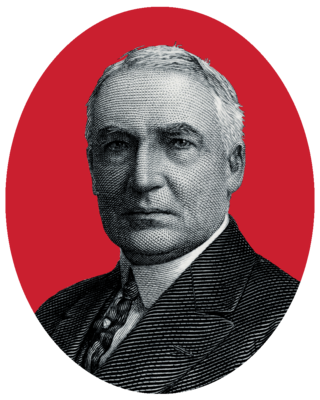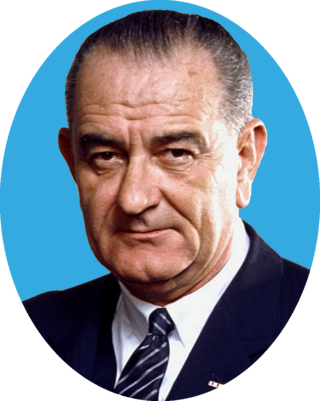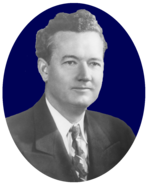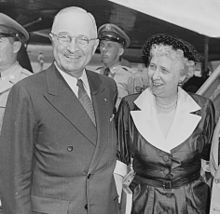
The 1952 United States presidential election was the 42nd quadrennial presidential election. It was held on Tuesday, November 4, 1952. Republican Dwight D. Eisenhower defeated Democratic Illinois Governor Adlai Stevenson II in a landslide victory, becoming the first Republican president in 20 years. This was the first election since 1928 without an incumbent president on the ballot.

The 1956 United States presidential election was the 43rd quadrennial presidential election. It was held on Tuesday, November 6, 1956. Incumbent Republican President Dwight D. Eisenhower and his running mate, incumbent Vice President Richard Nixon, were re-elected, defeating for a second time Democrat Adlai Stevenson II, former Illinois governor. This election was the sixth rematch in American presidential history, a situation which would not occur again until 2024. It was the second time in which the winner was the same both times, the first being William McKinley's victories over William Jennings Bryan in 1896 and 1900. This was the last election before term limits established by the 22nd Amendment, which applied to Eisenhower, were effective.

Adlai Ewing Stevenson II was an American politician and diplomat who was the United States Ambassador to the United Nations from 1961 until his death in 1965. He previously served as the 31st governor of Illinois from 1949 to 1953 and was the Democratic nominee for president of the United States in 1952 and 1956, losing both elections to Dwight D. Eisenhower in a landslide. Stevenson was the grandson of Adlai Stevenson I, the 23rd vice president of the United States.

Carey Estes Kefauver was an American politician from Tennessee. A member of the Democratic Party, he served in the U.S. House of Representatives from 1939 to 1949 and in the U.S. Senate from 1949 until his death in 1963.

The 1920 Republican National Convention nominated Ohio Senator Warren G. Harding for president and Massachusetts Governor Calvin Coolidge for vice president. The convention was held in Chicago, Illinois, at the Chicago Coliseum from June 8 to June 12, 1920, with 940 delegates. Under convention rules, a majority plus one, or at least 471 of the 940 delegates, was necessary for a nomination.
The 1948 Democratic National Convention was held at Philadelphia Convention Hall in Philadelphia, Pennsylvania, from July 12 to July 15, 1948, and resulted in the nominations of President Harry S. Truman for a full term and Senator Alben W. Barkley of Kentucky for vice president in the 1948 presidential election.

The 1952 Republican National Convention was held at the International Amphitheatre in Chicago, Illinois from July 7 to 11, 1952, and nominated Dwight D. Eisenhower of New York, nicknamed "Ike", for president and Richard M. Nixon of California for vice president.

The 1964 Democratic National Convention of the Democratic Party, took place at Boardwalk Hall in Atlantic City, New Jersey, from August 24 to 27, 1964. President Lyndon B. Johnson was nominated for a full term. Senator Hubert H. Humphrey of Minnesota was nominated for vice president. The convention took place less than a year after President John F. Kennedy was assassinated in Dallas, Texas, and Kennedy's legacy was present throughout the convention.

The 1960 Democratic National Convention was held in Los Angeles, California, on July 11–15, 1960. It nominated Senator John F. Kennedy of Massachusetts for president and Senate Majority Leader Lyndon B. Johnson of Texas for vice president.

The 1956 Democratic National Convention nominated former Governor Adlai Stevenson of Illinois for president and Senator Estes Kefauver of Tennessee for vice president. It was held in the International Amphitheatre on the South Side of Chicago from August 13 to August 17, 1956. Unsuccessful candidates for the presidential nomination included Governor W. Averell Harriman of New York, Senator Lyndon B. Johnson of Texas, and Senator Stuart Symington of Missouri.

The 1960 Republican National Convention was held in Chicago, Illinois, from July 25 to July 28, 1960, at the International Amphitheatre. It was the 14th and most recent time overall that Chicago hosted the Republican National Convention, more times than any other city.

From March 11 to June 3, 1952, voters and members of the Democratic Party elected delegates to the 1952 Democratic National Convention, partly for the purpose of choosing a nominee for president in the 1952 United States presidential election. Incumbent President Harry S. Truman declined to campaign for re-election after losing the New Hampshire primary to Senator Estes Kefauver of Tennessee. Kefauver proceeded to win a majority of the popular vote, but failed to secure a majority of delegates, most of whom were selected through other means.

This is the electoral history of Adlai Stevenson II, who served as Governor of Illinois (1949–1953) and 5th United States Ambassador to the United Nations (1961–1965), and was twice the Democratic Party's nominee for President of the United States, losing both the 1952 and 1956 presidential general elections to Republican Dwight D. Eisenhower.

George Miller Jr. was an American Democratic politician who served as a California State Assemblyman from 1947 to 1949 and a California State Senator from 1949 to 1969. He was a leader of the liberal wing of the California Democratic Party in the early 1950s when the Republican Party dominated state government. Miller was the father of U.S. Representative George Miller III.

This article lists those who were potential candidates for the Democratic nomination for Vice President of the United States in the 1952 election. After winning the presidential nomination on the third ballot of the 1952 Democratic National Convention, Illinois Governor Adlai Stevenson consulted with Democratic Party leaders such as President Harry S. Truman and Speaker Sam Rayburn. Stevenson chose Alabama Senator John Sparkman, a Southern centrist, as his running mate. Sparkman won the vice presidential nomination on the first ballot as no serious rival tried to displace Stevenson's choice. However, many Northerners were not enthused with the choice of Sparkman due to Sparkman's stance on civil rights. During the 1952 convention, Sparkman, who had supported Senator Richard Russell for president, played a part in watering down the party's platform on civil rights. New York Representative Adam Clayton Powell Jr. and others walked out of the convention after the choice of Sparkman was announced. The Democratic ticket lost the 1952 election to the Republican ticket of Dwight D. Eisenhower and Richard Nixon.

Senator Richard M. Nixon's speech at a state Republican Party fundraiser in New York City on May 8, 1952, impressed Governor Thomas E. Dewey, who was an Eisenhower supporter and had formed a pro-Eisenhower delegation from New York to attend the national convention. In a private meeting after the speech, Dewey suggested to Nixon that he would make a suitable vice presidential candidate on the ticket with Eisenhower.

The 1956 United States presidential election in Minnesota took place on November 6, 1956, as part of the 1956 United States presidential election. Voters chose 11 electors, or representatives to the Electoral College, who voted for president and vice president.

The 1952 United States presidential election in Illinois took place on November 4, 1952, as part of the 1952 United States presidential election. State voters chose 27 representatives, or electors, to the Electoral College, who voted for president and vice president.

The selection of the Democratic Party's vice presidential candidate for the 1956 United States presidential election occurred at the party's national convention on August 16, 1956. Former presidential candidate and Tennessee's Senator Estes Kefauver defeated Massachusetts' Senator John F. Kennedy.















































